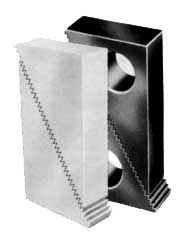
Workpieces often require clamping. Whether you’re cutting, forming or assembling a workpiece, you may need to clamp it in place. Allowing the workpiece to move freely could result in damage. Rather than only using a clamp, though, you may want to use a step block. A step block will allow you to adjust the height of the clamp while stabilizing and securing the workpiece in place.
What Are Step Blocks?
Step blocks are block-shaped parts that are used in conjunction with a clamp to secure workpieces. They consist of two parts. As shown in the photo above, step blocks are essentially sliced diagonally to create two parts. They have a bottom triangle part and a top triangle part. When placed together, these two parts will form the step block.
The surface where the two triangle blocks meet isn’t smooth. Rather, it features ridges or “teeth.” These ridges allow the top part to sit anywhere on the bottom part. Step blocks are self-locking in this regard. With ridges, the top part will lock into the bottom part.
How Step Blocks Work
Step blocks work by supporting and raising the height of the clamp. You can use either the bottom part of a step block or both parts of a step block. When using the bottom part, you’ll need to place it against the back of the clamp. The back of the clamp will rest on the step block’s teeth, thus stabilizing it.
You can use both parts of a step block to support a clamp. Using both the top and bottom parts will allow you to raise the clamp higher. Step blocks are self-locking. You can move the top part higher along the ridges of the bottom part. Raising the top part will create an elevated surface with which you can support the clamp. And if you need to lower the clamp, you can move the top part of the step block to a lower position on the bottom part.
Choosing Step Blocks
Step blocks are available in different sizes. When shopping for step blocks, you may notice a specification for half-block height. Half-block height refers to the height of either the top or bottom part when used alone. There’s also full-block height. As you may have guessed, full-block height is the height of a step block when both the top and bottom parts are combined.
